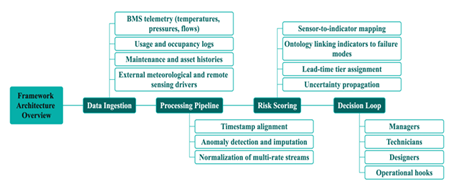Redefining Early Warning Frameworks for Predictive Maintenance in Service Intensive Building Systems
Main Article Content
Abstract
This paper presents a multi-failure-risk early warning framework for building services to reduce unexpected heating, ventilation, and air conditioning downtime and service losses. Many deployments still rely on reactive maintenance and simple thresholds that provide limited lead time and overlook interacting failure modes. The framework defines an indicator taxonomy from environmental, usage, and asset-history signals; ingests multi-rate building management system (BMS) telemetry with documented provenance; aligns timestamps, imputes anomalies, normalizes streams, and propagates uncertainty into normalized risk scores. An ontology links indicators to failure modes and lead-time tiers, and a triage loop integrates managers, technicians, and designers. Evaluation uses Root Mean Squared Error (RMSE), Mean Absolute Error (MAE), and Nash-Sutcliffe Efficiency (NSE) with non-random splits, rolling-origin tests, bootstrap intervals, and cost-weighted thresholds. Results across sites indicate more stable detection accuracy, precision/recall, lead time to failure, and false-alarm rates after threshold calibration; ablations show environmental and usage indicators dominate signal, while historical asset priors improve calibration and transfer. Cross-site transfer generally holds with degradation under lower data volume, and augmentation sustains recall under label scarcity. The contribution is a reproducible, operations-aligned protocol that unifies indicator taxonomy, multi-failure reasoning, and uncertainty handling. Practitioners can deploy the framework to prioritize interventions that mitigate downtime, improve comfort, and better allocate maintenance resources.
Article Details

This work is licensed under a Creative Commons Attribution-ShareAlike 4.0 International License.

